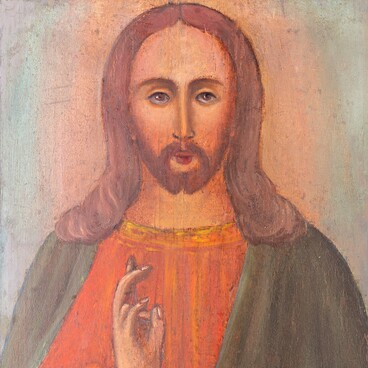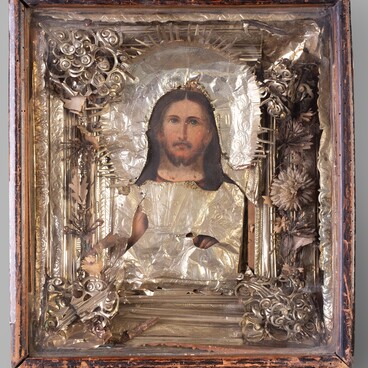Various iconographic types depicting the Mother of God in Russian church art reflect all the stages of the Blessed Virgin’s life from her conception (“Joachim and Anne Meeting at the Golden Gate”) to the Assumption and her intercession for the human race after her earthly life. It is to her, to the Intercessor, that Orthodox Christians always pray in the first place. A particularly reverent attitude has developed towards those types where the Mother of God is depicted together with the Baby, in which her Motherhood is clearly manifested. The image in the presented icon is almost completely covered by a revetment made of foil which imitates gilding. Only Their faces and arms and the legs of the Baby are painted.
The composition most closely corresponds to the Hodegetria type (Our Lady of the Way): the Infant Jesus sits in the arms of the Most Pure Theotokos, blessing the worshiper with His right hand. The Mother of God holds her Son with one hand, and with the other points to Him as the Heavenly King and Judge who has appeared in this world.
According to church history, the first Hodegetria image was painted by Luke the Evangelist. Another legend tells of a miraculous image that appeared during the period of iconoclasm on a pillar of a church in Lod. The copy of this image was revered as miraculous.
In the 5th century, Empress Eudoxia brought the icon from the Holy Land to Constantinople. The original was lost in the mid-15th century — probably destroyed by Ottoman soldiers — but there are many copies left.
There are insignificant differences in various versions of this image: it can be a full, waist or shoulder-length image of the Virgin; the Mother of God can face the beholder or slightly bow her head to her Son. Christ is always depicted frontally; in His left hand He holds a book or scroll as a symbol of the incarnate Word of God.
The icon presented in the exhibition does not fully correspond to the described canon: there is no scroll (book) and Jesus does not face the viewer strictly frontally. In addition, traditionally in Hodegetria images, the Virgin’s head is covered only by a maphorion (a wide veil). In this image, the icon’s revetment shows her in royal attire and a crown. These features bring the image closer to Theotokos Panachranta (from Greek Πανάχραντα — “All-Immaculate”). Such icons are similar to Hodegetria ones, but the Mother of God is represented in them as the Queen sitting on a throne with the Royal Baby on her lap. This type became popular in Byzantium and Rus in the 11th century. Later, several independent images were developed on its basis, including Our Lady Derzhavnaya (“Sovereign”) and the Mother of God of Kyiv-Pechersk.
The composition most closely corresponds to the Hodegetria type (Our Lady of the Way): the Infant Jesus sits in the arms of the Most Pure Theotokos, blessing the worshiper with His right hand. The Mother of God holds her Son with one hand, and with the other points to Him as the Heavenly King and Judge who has appeared in this world.
According to church history, the first Hodegetria image was painted by Luke the Evangelist. Another legend tells of a miraculous image that appeared during the period of iconoclasm on a pillar of a church in Lod. The copy of this image was revered as miraculous.
In the 5th century, Empress Eudoxia brought the icon from the Holy Land to Constantinople. The original was lost in the mid-15th century — probably destroyed by Ottoman soldiers — but there are many copies left.
There are insignificant differences in various versions of this image: it can be a full, waist or shoulder-length image of the Virgin; the Mother of God can face the beholder or slightly bow her head to her Son. Christ is always depicted frontally; in His left hand He holds a book or scroll as a symbol of the incarnate Word of God.
The icon presented in the exhibition does not fully correspond to the described canon: there is no scroll (book) and Jesus does not face the viewer strictly frontally. In addition, traditionally in Hodegetria images, the Virgin’s head is covered only by a maphorion (a wide veil). In this image, the icon’s revetment shows her in royal attire and a crown. These features bring the image closer to Theotokos Panachranta (from Greek Πανάχραντα — “All-Immaculate”). Such icons are similar to Hodegetria ones, but the Mother of God is represented in them as the Queen sitting on a throne with the Royal Baby on her lap. This type became popular in Byzantium and Rus in the 11th century. Later, several independent images were developed on its basis, including Our Lady Derzhavnaya (“Sovereign”) and the Mother of God of Kyiv-Pechersk.


